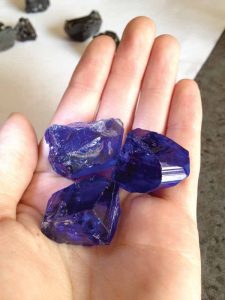Heating up the tanzanite trade

A rumour recently started in the gemmology world, saying a new source of tanzanite (our favourite blue-violet gemstone!) had been discovered near Mount Kilimanjaro in Tanzania. This would mean the tanzanite mining quarries in the Mirerani Hills are not the only ones in the world anymore.
The news surfaced back in April, but little information on the exact location or future plans of the Tanzanian government has come to light since. Tanzania’s president, John Magufuli—who visited the existing quarries in the spring—said another source of the blue zoisite had been discovered, but did not mention the exact location.
“We have built a wall surrounding the mining quarries of Mirerani in order to curb the notorious theft and smuggling of tanzanite,” said Magufuli while inaugurating the 25-km (15 ½-mi) long fort, described as the ‘Great Wall of Mirerani.’ “The tanzanite mine has been the victim of countless acts of violence and theft in the past year, and the company was worried for its employees’ security. Hence, the decision to build a wall around it to try and deter the aggressors and thieves.”
It seems the same strategy will be employed at the new source as well.
“We have also just discovered a new location where there are ample tanzanite reserves underground,” added Magufuli. “Soon, this location will also be surrounded by a wall before mining operations start.”
The news being fairly fresh and the new location yet to be named, we’ll have to wait and see on this rumour, although it could change the marketing of the blue-violet gemstone. What would it mean for the gemmology world? Could the ‘gemstone of a generation’ be with us for much longer than we thought?
Looking ahead

Discovering a new source of tanzanite could either have devastating effects on the market for this gem or allow for more people to buy it should the price be reduced. After all, the stone’s current marketing is entirely based on the fact it is unique. Its nickname (the ‘gemstone of a generation’) comes from the fact there has traditionally been only one source of this treasure. The geological phenomenon that permitted tanzanite to be created, while not really unique, was a very special set of events within the Earth’s crust; the chances of it happening again elsewhere, with the same elements present, was next to none.
In other words, now that a new source has been found and we will have a lot more tanzanite on the market than we predicted, we may have to revise our marketing of this beautiful stone.
On the other side of the coin, finding a new source could be good for business. Tanzanite’s cost could lower somewhat, making it more approachable to a wider range of customers. Getting it off its pedestal will do nothing to take away from its beauty, and it will still be rare and difficult to find, as two mines would hardly be too much for the market.
Brightening the future
We tend to forget gemstones—whether citrine, garnet, tourmaline, or any other type—are still rare, still precious gems, and still beautiful. Newly discovered mines and gemstones will always benefit the gemmology world, because giving our clients more choice and a bigger price range can only help the business. Additionally, the more we show we know about these discoveries and the goings-on of the jewellery market, the more clients will be impressed and want to put trust in our businesses.
Pantone may have decided Ultra Violet was the colour of the year for 2018, but our favourite (and new favourite) blue gemstones are not letting go of their crown just yet!
 Lauriane Lognay is a fellow of the Gemmological Association of Great Britain (FGA), and has won several awards. She is a gemstone dealer working with jewellers to help them decide on the best stones for their designs. Lognay is the owner of Rippana Inc., a Montréal-based company working internationally in coloured gemstone, lapidary, and jewellery services. She can be reached via e-mail by contacting rippanainfo@gmail.com.
Lauriane Lognay is a fellow of the Gemmological Association of Great Britain (FGA), and has won several awards. She is a gemstone dealer working with jewellers to help them decide on the best stones for their designs. Lognay is the owner of Rippana Inc., a Montréal-based company working internationally in coloured gemstone, lapidary, and jewellery services. She can be reached via e-mail by contacting rippanainfo@gmail.com.





